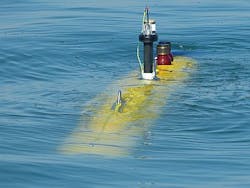Bluefin officials announced this week they have completed deep-water testing of a specialized UUV for the U.S. Defense Advanced Research Projects Agency (DARPA) in Arlington, Va., as part of the DARPA Deep Sea Operations (DSOP) program.
DARPA DSOP seeks to find revolutionary advances in extremely deep-operating undersea surveillance systems to protect U.S. Navy aircraft carriers and their support vessels from quiet enemy attack submarines.
Bluefin experts developed the deep-diving UUV system under a phase II subcontract from Applied Physical Sciences Corp. (APS) in Groton, Conn., for the DARPA DSOP program. DSOP is part of DARPA's Distributed Agile Submarine Hunting program (DASH), which aims to develop affordable distributed technology to address anti-submarine warfare (ASW) surveillance needs over large areas.
APS won a $15.2 million DARPA phase 2 DSOP contract in March to define a developmental sonar system. The DSOP program seeks to use deep-sea areas called the sound fixing and ranging channel -- also known as the deep sound channel -- that exists at ocean depths below about 3,000 feet where the water is cold, silent, and dense, and where the speed of sound is at its slowest.
Conditions in these areas act as a sound waveguide that enables low-frequency sound waves to travel for thousands of miles. DARPA wants APS and partner Bluefin to develop sensors that essentially look upward through this acoustically silent environment to detect the low-frequency sounds of enemy submarines against a quiet background at long ranges.
DARPA experts assume that deep-ocean areas are particularly advantageous for sound navigation and ranging technologies -- sonar for short -- yet will accept non-acoustic solutions, as well.
Technologies that APS and Bluefin will develop could result in sensors that operate near the ocean bottom; take advantage of distributed nodes; can be configured to a range of operations, and environments; and adapt to the mobility of friendly and enemy submarines and surface warships.
The tests that Bluefin conduced for APS provided Bluefin an opportunity to vet several vehicle capabilities for the company's modular UUVs including an extended operational depth rating, an advanced pressure vessel design, a power system, a high-powered acoustics transducer system, and a transportable docking head launch and recovery system.
During the tests Bluefin experts conducted six days of evaluations, including two dives to 14,600 feet totaling 11 hours. Bluefin and APS experts are integrating a deep-sea sonar into the Bluefin UUV, and are building a second UUV system with sonar to support networked operations, as part of the DSOP program.
For more information contact Bluefin Robotics online at www.bluefinrobotics.com, Applied Physical Sciences at http://aphysci.com, or DARPA at www.darpa.mil.



